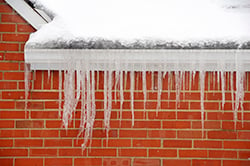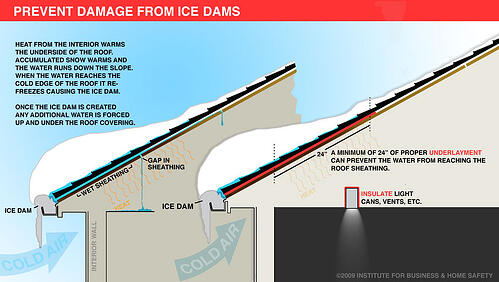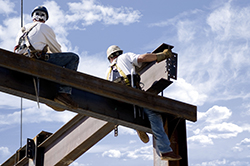 As if the cold weather and snow weren’t enough to deal with, the winter also brings the danger of ice dams. The combination of snow on your roof, the freezing temperatures, and heat escaping from your home can create chunks of ice along edges of your roof. This prevents melted snow from draining off. The backup of water created can then leak into the home and cause significant damage.
As if the cold weather and snow weren’t enough to deal with, the winter also brings the danger of ice dams. The combination of snow on your roof, the freezing temperatures, and heat escaping from your home can create chunks of ice along edges of your roof. This prevents melted snow from draining off. The backup of water created can then leak into the home and cause significant damage.
To learn more about how ice dams form, take a look at the resources provided at the Insurance Institute for Business & Home Safety (IBHS) and University of Minnesota.
How Can You Prevent Ice Dams?
If you live in cold weather states, you can’t avoid winter weather. But you can take steps to help prevent ice dams from forming on your home or business.

Photo from IBHS
Immediate action:
- Remove snow from the roof after each snow storm. You can use a roof rake or a push broom, but be careful as these may damage roofing materials. Roof rakes are available with wheels to help prevent damage to your roof.
- Make sure the area around downspouts are clear to allow proper drainage from your gutters.
Long-term action:
- Improve attic insulation. Seal openings where warm, moist air from your home could be flowing into the attic area. This could be exhaust fans, chimneys, light fixtures, vent pipes, and attic hatches.
- Check your attic ventilation. If heat from the home does enter the attic, proper ventilation can help that heat rise and escape.
- When it is time to replace your roof, have a water-repellant membrane installed under the shingles to provide an added barrier in preventing water from getting into the home.
If You Have An Ice Dam…What NOT To Do:
- Do not try to get onto the roof. A roof rake can help you reach the roof from a safe spot on the ground. Do not pull the snow sideways or against the slope as it could cause damage to your shingles.
- If you cannot safely reach the roof with a roof rake or push broom, seek assistance. Hire a professional to help remove the snow.
- Do not try to hack away at the dam. It is dangerous for you and could damage your roofing.
- Do not attempt to melt the snow and ice with salt. The chemicals can damage your gutter, downspouts, and nearby landscaping.
If you do suffer damage from winter weather, do you understand what your homeowners policy covers? Check out our blog about homeowners insurance and winter storm damage.
The cost to have snow removed from your roof with proper equipment or by a professional, as well as the costs to improve attic insulation, is likely much less expensive than the damage which could be caused by ice dams. Prepare your home before the winter weather strikes, and be ready for when the snow does come.





